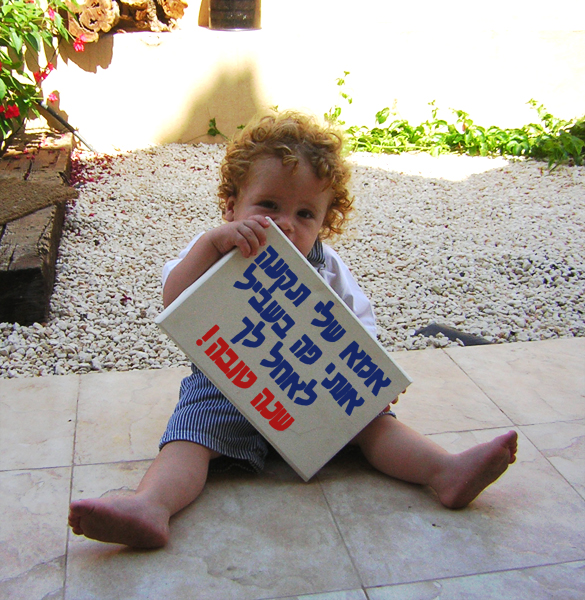Tashlich: A Rosh Hashanah Tradition
https://www.youtube.com/watch?v=JmlPBP3fC1k&list=WL&index=63
Tashlich – um eco-lógico
© Jane Bichmacher de Glasman*
No primeiro dia de Rosh Hashaná, quando não coincide com Shabat, é realizado o ritual de Tashlich. Consiste em ir, pouco antes do pôr-do-sol, até um lugar onde haja água natural corrente (lagos, rios ou mar) e também peixes. Lá meditamos, recitamos alguns salmos e agitamos simbolicamente os cantos das roupas. Alguns lançam na água migalhas de pão, que simbolizam resíduos desintegrados das faltas cometidas por nós durante o ano que se encerra.
Os versos do profeta Miquéias (especialmente 7:19), recitados no Tashlich, contêm a explicação para o costume: “E jogarás (tashlich) teus pecados nas profundezas do mar”.
Naturalmente, sacudir os cantos da roupa não nos livra de nossos pecados - mas nos recorda de que devemos fazer uma boa limpeza no coração e livrá-lo do mal.
Quando o primeiro dia de Rosh Hashaná ocorre num Shabat, o Tashlich é observado no segundo dia.
A prece de Tashlich desperta para o arrependimento. Lembra a insegurança da vida do peixe, entre o perigo da isca e da rede do pescador. Nossa vida também está repleta de ciladas e tentações. O peixe também simboliza o "olho sempre vigilante" de D’us, pois os peixes não têm pálpebras, seus olhos estão sempre abertos. Assim, se nada pode ser oculto de D'us, também podemos extrair coragem e esperança da fé nele, pois Ele nunca dorme[1].
“Água em hebraico é Maim, palavra que está presente em Sha-maim que quer dizer céus, pois queremos que nossa oração chegue lá, para o reencontro das águas de cima com as águas de baixo, como no início da criação do mundo[2]”.
Na Idade Média o Tashlich foi muitas vezes usado para acusar os judeus de enfeitiçar a água ou envenená-la, e os rabis eram obrigados a proibir a observância do Tashlich pelas suas comunidades, já que constituía ameaça às suas vidas.
A pessoas associam o ritual de Tashlich com “jogar fora” - idéia incorreta, sob uma perspectiva “eco-kasher”. Hoje sabemos que não é possível jogar nada fora, porque o “fora” não existe. Ao invés disso, lançamos nossos desacertos ou transgressões para serem neutralizados, para que se tornem biodegradáveis, para que desta forma possam ser reciclados sem causar poluição. Refletindo sobre cada erro que simbolicamente é lançado às águas, pensando sobre o que aprendemos com ele, podemos “reciclá-lo”, transformando-o em potencial para ações positivas.
A água faz parte dos rituais judaicos de purificação, como os banhos de imersão na mikve, por exemplo, que realizamos antes do Shabat, festas ou momentos especiais. Em Rosh haShaná a água simboliza o meio no qual reciclamos situações ou relações não resolvidas até o início do novo ano[3].
A lágrima é nossa emoção reciclada através da água. Através do Tashlich, fazemos um percurso inverso ao de Narciso, que no mito se apaixona por sua própria imagem: lançamos cacos de nosso coração partido às águas, que são suas imperfeições, como forma de reficarmos inteiros, completos. Em Shalom, cuja raiz significa isso: inteiro, perfeito. E “nada é mais inteiro que um coração partido...[4]”
* Doutora em Língua Hebraica, Literaturas e Cultura Judaica, Professora Adjunta, Fundadora e ex-Diretora
do Programa de Estudos Judaicos –UERJ, escritora.
Publicado em Visão Judaica72, setembro de 2008
[2] Citando Benjamin Mandelbaum, em Tashlich: a Cabala do Desapego www.cjb.org.br/netsach/festas/kipur/taschlich.htm
[4] A frase é do Rabi Menachem Mendel de Kotzk (Polônia, 1787-1859), um dos grandes líderes hassídicos do século XIX.
Tashlich
– an echo-logical
– an echo-logical
© Jane Bichmacher
de Glasman*
de Glasman*
In the first day of Rosh Hashanah, when it does not coincide with Shabbat, the ritual of Tashlich
is performed. It consists of going, a short while before sunset, to a place
where there is current natural water (lakes, rivers or sea) and also fish.
There, we meditate, recite some psalms and agitate symbolically the corners of
the clothes. Some people throw in the water bread crumbs, which symbolize
disintegrated residues of the absences we did during the year that is being closed.
is performed. It consists of going, a short while before sunset, to a place
where there is current natural water (lakes, rivers or sea) and also fish.
There, we meditate, recite some psalms and agitate symbolically the corners of
the clothes. Some people throw in the water bread crumbs, which symbolize
disintegrated residues of the absences we did during the year that is being closed.
The verses of the prophet Micah (especially 7:19),
recited in the Tashlich, contains the
explanation for the custom: "And
you will cast (tashlich) your sins into
the depths of the sea".
recited in the Tashlich, contains the
explanation for the custom: "And
you will cast (tashlich) your sins into
the depths of the sea".
When the first day of Rosh Hashanah falls on Shabbat,
the Tashlich is said on Sunday,
the second day.
the Tashlich is said on Sunday,
the second day.
Naturally, to shake the corners of the clothes does
not shed our sins - but reminds us that we should do a good cleaning within the
heart and free him from evil.
not shed our sins - but reminds us that we should do a good cleaning within the
heart and free him from evil.
The prayer of Tashlich
awakes for regret. It reminds us of the fish life insecurity, between the bait
danger and the fisherman net. Our life also is full of ambushes and
temptations. The fish symbolizes the "always vigilant eye" of God: as
a fish do not have eyelids, its eyes are always open. Therefore, if nothing can
be hidden from God, in the other hand we can obtain boldness and hope from the
faith in him, as He never sleeps.
awakes for regret. It reminds us of the fish life insecurity, between the bait
danger and the fisherman net. Our life also is full of ambushes and
temptations. The fish symbolizes the "always vigilant eye" of God: as
a fish do not have eyelids, its eyes are always open. Therefore, if nothing can
be hidden from God, in the other hand we can obtain boldness and hope from the
faith in him, as He never sleeps.
Water in Hebrew is Mayim,
word present in Shamayim that means
heavens, because we want that our prayer arrive there, for the above and under
waters reunion, as in the beginning of the Creation.
word present in Shamayim that means
heavens, because we want that our prayer arrive there, for the above and under
waters reunion, as in the beginning of the Creation.
In Medieval Time, Tashlich
was many times used to accuse Jews of bewitching or poisoning the water and rabbis
had to prohibit Tashlich observance
by their communities, since it threatened their lives.
was many times used to accuse Jews of bewitching or poisoning the water and rabbis
had to prohibit Tashlich observance
by their communities, since it threatened their lives.
People associate the ritual of Tashlich with "throwing away" - incorrect idea, under an
"eco-kosher" perspective. Today we know that is impossible to throw
anything away, outside, because the "outside" does not exist.
Instead, we cast our mistakes or transgressions to be neutralized, to become
biodegradable, so this way they should be able to be recycled without causing
pollution. Thinking about each mistake that symbolically is thrown into the
waters, thinking about what we learned with it, we are able to
"recycle", transforming it in potential for positive actions.
"eco-kosher" perspective. Today we know that is impossible to throw
anything away, outside, because the "outside" does not exist.
Instead, we cast our mistakes or transgressions to be neutralized, to become
biodegradable, so this way they should be able to be recycled without causing
pollution. Thinking about each mistake that symbolically is thrown into the
waters, thinking about what we learned with it, we are able to
"recycle", transforming it in potential for positive actions.
Water is part of Jewish rituals of purification, as
the immersion baths in the mikveh,
for example, that we take before Shabbat or festivals.
the immersion baths in the mikveh,
for example, that we take before Shabbat or festivals.
In Rosh Hashanah,
water symbolizes the environment in which we recycle situations or relationships
not solved until the beginning of the New Year.
water symbolizes the environment in which we recycle situations or relationships
not solved until the beginning of the New Year.
The tear is our emotion recycled through water.
Through the Tashlich,
we follow a reverse way to that of Narcissus, who in the myth falls in love
with his own image: we throw into the water shards of our broken heart, which
are its imperfections, as forms of re-being entire, complete. In Shalom, whose root means it: entire,
perfect. And "nothing is more entire than a broken heart...”
we follow a reverse way to that of Narcissus, who in the myth falls in love
with his own image: we throw into the water shards of our broken heart, which
are its imperfections, as forms of re-being entire, complete. In Shalom, whose root means it: entire,
perfect. And "nothing is more entire than a broken heart...”
* Jane
Bichmacher de Glasman is a writer, Ph.D. in Hebrew Language, Jewish Literatures
and Culture, Creator and former-director of the Program of Jewish Studies at
State University of Rio de Janeiro (UERJ), Professor and coordinator of the
Department of Hebrew Studies at UERJ and UFRJ (retired).
Bichmacher de Glasman is a writer, Ph.D. in Hebrew Language, Jewish Literatures
and Culture, Creator and former-director of the Program of Jewish Studies at
State University of Rio de Janeiro (UERJ), Professor and coordinator of the
Department of Hebrew Studies at UERJ and UFRJ (retired).
Published
in Visão Judaica 72, September 2008 (In Portuguese) and Jewish Magazine Issue
Number 147 - High Holiday Issue,
September 2010.
in Visão Judaica 72, September 2008 (In Portuguese) and Jewish Magazine Issue
Number 147 - High Holiday Issue,
September 2010.












































































































































































































































































